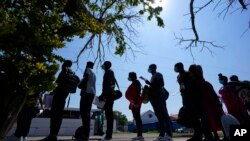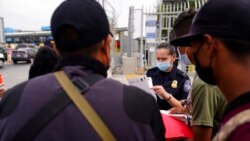A recent report from the Office of the Inspector General (OIG) calls for the Department of Homeland Security (DHS) to improve COVID-19 detection and prevention measures at the U.S.-Mexico border amid record-setting migrant arrivals.
"Without stronger COVID-19 prevention measures in place, DHS is putting its workforce, support staff, communities, and migrants at greater risk of contracting the virus," the report says.
Between March and May of this year, investigators reviewed DHS’s COVID-19 guidelines and discovered several problems with the agency's efforts to stop the virus from spreading among migrants detained at border holding facilities.
The review showed that U.S. Customs and Border Protection (CBP), one of DHS’s subagencies responsible for the detention of migrants at the U.S.-Mexico border, is unable to keep vast numbers of migrants properly distanced from each other.
Currently, there is no federal requirement for COVID-19 testing of migrants at the southwest border, but DHS says it has followed guidance from the U.S. Centers for Disease Control and Prevention for preventing COVID-19 transmission.
According to the report, CBP "does not conduct COVID-19 testing for migrants who enter CBP custody and is not required to do so. Instead, CBP relies on local public health systems to test symptomatic individuals."
Are migrants at the border being tested?
Not initially when taken into U.S. custody. However, for migrants who are transferred or released from CBP custody into the United States, the agency says it coordinates with other federal, state and local partners to test them for COVID-19.
The OIG report notes, however, that the agency is duty-bound to screen for COVID-19 symptoms and other health problems prior to a migrant’s transfer or release.
“According to CBP’s policy and guidance, once taken into custody, migrants are to receive a health screening to identify any potential medical issues or whether an individual may have COVID-19 symptoms, such as fever, chills, cough, or shortness of breath,” the report said.
If a migrant in custody is suspected of having COVID-19, CBP procedure dictates that officials contact the local public health department and then transfer the individual to a hospital for testing. But the OIG report noted that doing so is not always “operationally feasible, especially during an influx of migrant crossings at the southwest border.”
What is happening on the ground?
In August, Pete Saenz, a mayor from the U.S. border city of Laredo, Texas, told a local news outlet that CBP was not testing migrants prior to their release. Instead, shelters such as Holding Institute in Laredo and Catholic Charities of the Rio Grande Valley were administering tests after migrants were released to them from federal custody.
Saenz said the city was coordinating with the federal government, nonprofits and other local city governments to offer masks and provide additional hygienic resources.
“The reason why we don’t do testing is that once you test, there’s an obligation,” Saenz said. “If they’re positive, we’re told that you have to quarantine [them]. We don’t have the infrastructure for that.”
What was DHS’s response?
The inspector general’s office recommended that DHS “reassess its COVID-19 response framework to identify areas for improvement” and urged all agencies involved to coordinate with DHS’s chief medical officer to boost resources and ensure operational safety.
DHS accepted the recommendations and said the agency would “continue to implement improvement actions based on active monitoring and impact analysis of mitigation efforts.”
Jim H. Crumpacker, director of the department’s GAO-OIG liaison office, wrote in a letter included in the report saying that “DHS is committed to the well-being of the communities in which we serve, our workforce, and people in our care and custody.”
Has the report impacted political debate?
For months, Republican lawmakers have argued that the crowded and chaotic situation at the U.S.-Mexico border constitutes a health threat to the United States during the pandemic.
In August, a group of House Republicans wrote a letter to DHS Secretary Alejandro Mayorkas requesting more details on COVID-19 guidelines at the border. Lawmakers cited reports from a whistleblower that migrants were being released into the country without health screenings, a situation they said could cause “widespread COVID-19 infections and fatalities.”
For its part, the Biden administration has relied on a public health policy held over from the Trump administration to deny asylum claims filed by most migrants other than unaccompanied minors and families with young children.
On Thursday, a federal judge ordered a halt to the expulsion of migrant families. The ruling would go into effect September 30.










